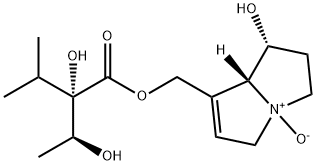lycopsamine N-oxide

|
- $180 - $701
- Product name: lycopsamine N-oxide
- CAS: 95462-15-0
- MF: C15H25NO6
- MW: 315.36
- EINECS:
- MDL Number:MFCD31697780
- Synonyms:lycopsamine N-oxide;(1R,7aR)-2,3,5,7a-Tetrahydro-1α-hydroxy-7-[[(2S,3S)-2,3-dihydroxy-2-isopropylbutyryl]oxymethyl]-1H-pyrrolizine 4-oxide;Butanoic acid, 2-hydroxy-2-[(1S)-1-hydroxyethyl]-3-methyl-, [(1R,7aR)-2,3,5,7a-tetrahydro-1-hydroxy-4-oxido-1H-pyrrolizin-7-yl]methyl ester, (2S)-;(+)-Lycopsamine N-Oxide;DNAWGBOKUFFVMB-FVZLBROTSA-N
2 prices
Selected condition:
Brand
- Sigma-Aldrich
- TRC
Package
- 0.5mg
- 5mg
- ManufacturerSigma-Aldrich
- Product numberPHL83447
- Product descriptionLycopsamine N-oxide phyproof Reference Substance
- Packaging5mg
- Price$701
- Updated2024-03-01
- Buy
- ManufacturerTRC
- Product numberL487530
- Product description(+)-LycopsamineN-Oxide
- Packaging0.5mg
- Price$180
- Updated2021-12-16
- Buy
| Manufacturer | Product number | Product description | Packaging | Price | Updated | Buy |
|---|---|---|---|---|---|---|
| Sigma-Aldrich | PHL83447 | Lycopsamine N-oxide phyproof Reference Substance | 5mg | $701 | 2024-03-01 | Buy |
| TRC | L487530 | (+)-LycopsamineN-Oxide | 0.5mg | $180 | 2021-12-16 | Buy |
Properties
Melting point :>70°C (dec.)
storage temp. :-20°C
solubility :Chloroform (Slightly), Methanol (Slightly)
pka :12.54±0.29(Predicted)
form :Solid
color :White to Light Yellow
Stability :Hygroscopic
storage temp. :-20°C
solubility :Chloroform (Slightly), Methanol (Slightly)
pka :12.54±0.29(Predicted)
form :Solid
color :White to Light Yellow
Stability :Hygroscopic
Safety Information
| Symbol(GHS): |

|
|||||||
|---|---|---|---|---|---|---|---|---|
| Signal word: | Danger | |||||||
| Hazard statements: |
|
|||||||
| Precautionary statements: |
|
Description
(+)-Lycopsamine N-Oxide, is occurs in pyrrolizidine alkaloid-containing plants, which are the most common poisonous plants affecting livestock, wildlife, and humans. Thye are being known as hepatotoxins and tumorigens.Suppliers and manufacturers
J & K SCIENTIFIC LTD.
Shanghai TaoSu Biochemical Technology Co., Ltd.
Sigma-Aldrich
Biyu Biotechnology (Shanghai) Co., ltd
Chengdu Push Bio-Technology Co., Ltd.
Shenzhen Regent Biochemical Technology Co., Ltd.
Nanjing Digger Medical Technology Co. Ltd.
Shenzhen Polymeri Biochemical Technology Co., Ltd.
Chengdu Peter-like Biotechnology Co., Ltd.
TCI (Shanghai) Chemical Trading Co., Ltd.





